Baker Academic Early Church Collection (22 vols.)
Digital Logos Edition
Overview
Get a varied and diverse survey of the first four centuries of Christianity. Drawing mostly from Church Fathers and patristic texts, this collection provides an introduction to various orthodox and heretical writings and addresses their theologies, their impact on the early church’s development, their contemporary relevance, and common misconceptions on them among Christians today. The collection also illustrates how Montanism and Stoicism shaped early Christianity and analyzes the early church’s baptismal rites, views on social justice and ethics, and interpretation of the Genesis 1–3 narrative.
Get the source texts themselves—get the authoritative Fathers of the Church Series to study exactly what the early church believed.

- Contains contributions from scholars and theologians from various traditions
- Provides insights on the early church’s theological development
- Analyzes the historical and contemporary significance of the early Church Fathers and their writings
- Title: Baker Academic Early Church Collection
- Volumes: 22
- Publisher: Baker Academic
- Pages: 6,851
- Resource Type: Monographs; Collected Essays
- Topic: Early Church
- Apocalyptic Thought in Early Christianity edited by Robert J. Daly
- Athanasius by Peter J. Leithart
- Baptismal Imagery in Early Christianity: Ritual, Visual, and Theological Dimensions by Robin M. Jensen
- Beginnings: Ancient Christian Readings of the Biblical Creation Narratives by Peter C. Bouteneff
- The Early Church on Killing: A Comprehensive Sourcebook on War, Abortion, and Capital Punishment edited by Ronald J. Sider
- Evangelicals and Nicene Faith: Reclaiming the Apostolic Witness edited by Timothy George
- Getting to Know the Church Fathers: An Evangelical Introduction by Bryan M. Litfin
- Ignatius of Antioch and the Parting of the Ways: Early Jewish-Christian Relations by Thomas A. Robinson
- Jewish Believers in Jesus: The Early Centuries edited by Reidar Hvalvik and Oskar Skarsaune
- Loving the Poor, Saving the Rich: Wealth, Poverty, and Early Christian Formation by Helen Rhee
- Prophets and Gravestones: An Imaginative History of Montanists and Other Early Christians by William Tabbernee
- Stoicism in Early Christianity edited by Tuomas Rasimus, Troels, Engberg-Pederson, and Ismo Dunderberg
- Wealth and Poverty in Early Church and Society edited by Susan R. Holman
- Classical Christian Doctrine: Introducing the Essentials of the Ancient Faith by Ronald E. Heine
- The Theology of Augustine: An Introductory Guide to His Most Important Works by Matthew Levering
- Vincent of Lérins and the Development of Christian Doctrine by Thomas Guarino
- Basil of Caesarea by Stephen M. Hildebrand
- The Original Bishops: Office and Order in the First Christian Communities by Alistair C. Steward
- Early Christianity in Contexts: An Exploration across Cultures and Continents edited by William Tabbernee
- Early Christian Martyr Stories: An Evangelical Introduction with New Translations by Bryan M. Litfin
- The Holy Trinity in the Life of the Church edited by Khaled Anatolios
- Ancient Christian Worship: Early Church Practices in Social, Historical, and Theological Perspective by Andrew B. McGowan
This title is included in the following collections
You can save when you purchase this product as part of a collection.
Baker Ultimate Collection 2022...
$38,273.89$30,599.99
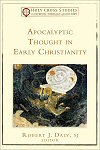
This volume explores how early Christian understandings of apocalyptic writings and teachings are reflected in the theology, social practices, and institutions of the early church. Experts on patristic and Byzantine Christianity present substantial samplings of biblical interpretation, theology, and visual art from first-millennium Christianity, especially from the East, to demonstrate the depth and variety of meaning early believers found in Daniel, Revelation, and related writings.
Contributors:
- Bogdan G. Bucur
- J.A. Cerrato
- Brian E. Daley
- Lorenzo DiTommaso
- Georgia Frank
- Dragos-Andrei Giulea
- Alexander Golitzin
- John Herrmann
- Annewies van den Hoek
- Bernard McGinn
- John A. McGuckin
- Elijah Nicolas Mueller
- Ute Possekel
- Nancy Patterson Ševcenko
- Theodore Stylianopoulos
The 15 contributing authors represent the cream of contemporary scholars in apocalyptic, and their essays reflect a broad, deep, and impeccable scholarship that often breaks new ground.
—David E. Aune, Walter Professor of New Testament and Christian Origins, University of Notre Dame
This wonderful volume illustrates the prevalence of apocalyptic themes in early Christianity from the book of Revelation to the Byzantine period. The essays range over a vast amount of material, including not only the church fathers but also apocryphal writings and early Christian art. Much of this material is known only to experts and is here made available to a broader readership. This is a first-rate contribution to the history of both apocalypticism and early Christianity.
—John J. Collins, Holmes Professor of Old Testament, Yale University
A much-needed, comprehensive, and rich study of the Apocalypse as it was read and imaged by early Christian thinkers and artists. This volume will be welcomed by anyone who wants to learn about the complex interpretations of the Bible’s last—and most puzzling—book.
—Robin Jensen, Luce Chancellor’s Professor of the History of Christian Art and Worship, Vanderbilt University
In contemporary theology, the category of the ‘apocalyptic’ has enjoyed revived interest through the works of thinkers such as Nathan Kerr and Louis Martyn. Such explorations invite an investigation into the Christian roots of this approach—an investigation gratefully provided in this volume. . . . The contributors of the 14 chapters cover a great deal of territory. . . . An excellent collection worth owning for anyone interested in patristic hermeneutics or contemporary conversations around the ‘apocalyptic.’
—Religious Studies Review
This book offers a breadth of perspectives on apocalyptic thought in early Christianity. . . . [It] provides an excellent introduction to the interpretation of Revelation and the transformation of broader Jewish apocalyptic themes in early Christianity. The indebtedness of Christianity to Jewish apocalyptic thought is made abundantly clear.
—Journal of Ecclesiastical History
Robert J. Daly is an emeritus professor at Boston College and chair of the Pappas Patristic Institute’s board. He is the author, editor, or translator of many scholarly books and articles on the early development of doctrine, patristics, biblical theology, biblical ethics, and liturgical worship.
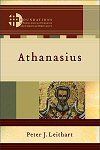
This erudite volume offers fresh consideration of the work of famous fourth-century church father Athanasius, giving specific attention to his use of Scripture, his deployment of metaphysical categories, and the intersection between the two. Peter Leithart not only introduces Athanasius and his biblical theology but also puts Athanasius into dialogue with contemporary theologians. The book draws on Athanasius’ theology to shed light on contemporary theological debates and defends him against contemporary criticisms of “classical theism.”
The action of this book occurs on three levels at least: most obviously, it is a presentation of Athanasius in his confrontation with Arianism; then, too, the author conducts his own engagement with some modern and contemporary scholars both in their interpretation of Athanasius and in their treatment of the substantive questions; and finally, some perennial issues of scriptural exegesis and hermeneutics peep more directly through in many places. Peter Leithart describes his governing systematic purpose as the ‘evangelization of metaphysics,’ and it may be affirmed that classical doctrines of the Trinity and the incarnation here shine through in all their soteriological strength.
—Geoffrey Wainwright, Cushman Professor of Systematic Theology, Duke Divinity School
If Christian theology had superheroes, Athanasius would perhaps lead the list thanks to his sometimes single-handed struggle to maintain Trinitarian orthodoxy. Leithart’s excellent study shows Athanasius to be christocentric in his biblical interpretation and theology long before Barth made it fashionable to be so. The ‘sense of the Fathers’ is indeed being visited upon their evangelical great-grandchildren, and with mostly salutary effect.
—Kevin J. Vanhoozer, research professor of systematic theology, Trinity Evangelical Divinity School
The knowledge [Leithart] gleaned from researching the fourth century combined with his interest in exegesis come through with striking clarity. . . . Leithart argues that Athanasius had a robust Christology that shaped each of his writings, so it is fitting that he also makes this the focus of his book. He is christocentric in numerous creative ways which add to the strength of this book. Leithart also has an impressive knowledge of the current debates and is conversant with a vast array of primary and secondary sources. . . . Athanasius is a great book for anyone interested in the Christological debates of the fourth century, TIS, or modern debates over Trinitarian issues. Leithart not only gives excellent insights into Athanasius’ polemics with Arius, but he does so in a unique and fresh way. . . . Leithart should be applauded for reminding us that Athanasius can continue to speak today with great force.
—Credo
Many aspects of this work will lead readers to value Leithart’s contribution. Students new to the field of patristics often search in vain for an introductory text—an issue that Leithart resolves in this book. He offers adequate citations that will introduce researchers to the key works associated with Athanasius and the broader field of study. Also, Leithart provides a helpful contribution to the field of hermeneutics in his discussion of Athanasius as a representative of the Nicene tradition of theological interpretation of Scripture. This aspect of his work helps readers understand Athanasius’ exegetical approach. . . . The author provides a systematic approach to understanding Athanasius, whose lack of systematization can prove difficult for the newcomer. . . . Leithart’s work is a welcome addition to the study of patristic exegesis and deserves close attention by students of historical theology. It will likely serve as an excellent option for seminary and graduate classes either as a primary text or as a resource for introducing the study of patristic theology.
—Themelios
Peter J. Leithart is a senior fellow of theology and literature and the dean of graduate studies at New Saint Andrews College. He serves as the organizing pastor of Trinity Reformed Church in Moscow, Idaho. Leithart is the author of numerous books, including 1 & 2 Kings in the Brazos Theological Commentary on the Bible and A House For My Name: A Survey of the Old Testament.
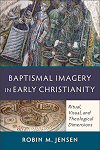
Robin Jensen, a leading scholar of early Christian art and worship, illuminates the theological meaning of baptism by exploring multiple dimensions of the early Christian baptismal rite. She examines five models for understanding baptism, showing how visual images, poetic language, architectural space, and symbolic actions signify and convey the theological meaning of this ritual practice. Considering image and action together, Jensen offers a holistic and integrated understanding of the power of baptism. The book is illustrated with photos and will be useful to professors and students in courses on theology, ritual studies, liturgy, and sacraments as well as to art historians and archaeologists.
This volume illumines the multiple biblical metaphors that evoke the meaning of baptism, offers a lucid and richly attested account of early church baptismal practices, and awakens the imagination of readers to engage in contemporary celebrations of baptism with renewed vitality. The book demonstrates that metaphor, architecture, visualization, and liturgy are not mere applications of theology but rather help constitute theology, and it does so in a way that is both accessible to students and instructive for veteran pastors and theological educators.
—John D. Witvliet, professor of worship, theology, and congregational and ministry studies, Calvin Institute of Christian Worship
Robin Jensen brings her scholarly acumen and aesthetic sensibility to the interpretation of the principal motifs of the early Christian baptismal ritual. Adding to her impressive writings on the subject of baptism, Jensen addresses this book to a more popular audience but with solid scholarly support. These thematic studies elucidate the effects and meaning of the baptismal liturgy as a sensory, symbolic, and spiritual experience for its recipients.
—Everett Ferguson, distinguished scholar in residence, Abilene Christian University
Robin Jensen’s attention to art and architecture is an important addition to existing scholarship that focuses primarily on texts. This fresh approach to the topic is carefully researched and amply illustrated. Christians concerned with a renewal of baptismal practice today will find a rich trove of biblical stories and metaphors that inspired and informed early Christian communities.
—Ruth A. Meyers, Hodges-Haynes Professor of Liturgics, Church Divinity School of the Pacific
What a gift Robin Jensen has given us in this book, a gift she is uniquely qualified to give. A scholar of Christian liturgy, doctrine, and art, Jensen presents the history of early Christian initiation the way it was experienced—as a unified whole. Integrating image with practice and interpretation, Jensen offers a deep and insightful look into early Christian baptism. Baptismal Imagery in Early Christianity is so clear and direct it can easily serve as a solid introductory text; at the same time it is so thoroughly researched it will serve scholars of early Christian history, liturgy, and art for years to come. This much-welcome and much-needed volume is not to be missed.
—Todd Johnson, William K. and Delores S. Brehm Associate Professor of Worship, Theology, and the Arts, Fuller Theological Seminary
This new study of baptism may be unique in exploring the early history of Christian initiation not through authors or ideas but symbols. Drawing material and literary evidence together in a deft and unprecedented way, Jensen reveals how early Christians themselves experienced their rite of initiation. The book, like the rite, is rich and diverse; it demonstrates the variety of baptismal images and understandings that could coexist and catalyze one another. Washing, community membership, illumination, rebirth, and new creation are all vividly drawn in word and image. This array of fundamental images and their ritualization provides new insight not only into baptism but also into the ways Christian identity itself was created and expressed.
—Andrew McGowan, warden, Trinity College, The University of Melbourne
Robin M. Jensen is Luce Chancellor’s Professor of the History of Christian Art and Worship at Vanderbilt University in Nashville, Tennessee. She has authored several books, including Face to Face: Portraits of the Divine in Early Christianity and Understanding Early Christian Art.
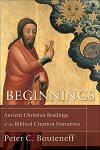
Recently renewed debates concerning creation and evolution make contemporary Christians wonder how their forebears in the faith understood the Genesis creation narratives. Were the stories of the six days and of the garden read historically, or did they have some other function? This volume from Peter Bouteneff brings needed attention to early Christian understandings of those key biblical texts.
After introductory chapters on the narratives and their reception in early Judaism and in the New Testament (especially in Paul’s letters), Bouteneff focuses on the church fathers. He considers how the narratives of Genesis 1–3 were read as foundational, authoritative texts during the formative centuries when the Greek fathers were laying the framework of Christian theology. Chapters are devoted to writers of the second century (the apologists, from Justin to Irenaeus), the third century (mainly Origen but also the Latin writer Tertullian), and the fourth century (Cyril of Jerusalem, Athanasius, and especially the three Cappadocian fathers). Bouteneff finds that from Paul onward, the primary interest in Adam was as a prefiguration of Christ. The six days of creation bespeak God’s ordered creation of the world through Christ, and early Christian readings of Genesis reflect Christ-centered understandings of providence and time.
Bouteneff’s engaging and informative study makes the Greek fathers’ thought accessible to biblical interpreters and theologians as well as pastors, students, and all who are interested in the early church and its use of the Bible.
This wonderfully researched and elegantly written book provides the reader with a compelling and trustworthy portrait of how the fathers of the church read the story of Adam and Eve. As Bouteneff tells that story we see that the tale of the fall is always contextualized within a narrative that celebrates the restoration and redemption of the human race.
—Gary Anderson, Hesburgh Professor of Catholic Theology, University of Notre Dame
I hope this remarkable study will be widely read and appreciated. From the start, the reader is obliged to grapple with questions about how a text is to be read when it can be demonstrated that layers of subsequent interpretation have had as much, if not more, influence than the text itself. And what more crucial text is there than Genesis 1–3, which has shaped Christian understanding of both creation and fall in ways that are now controversial, both within the churches and in the public domain? Though not always agreeing with the analyses presented here, I can guarantee that hardly anyone, whatever their starting point, will come away from this book without having found some new insight.
—Frances M. Young, emeritus professor, University of Birmingham
The volume is very useful for theologians, for biblical scholars interested in the Wirkungsgeschichte of these texts, and for students. . . . The author can be congratulated for this good, serious, and thorough treatment of the topic.
—Review of Biblical Literature
Bouteneff charts a fascinating history of a conversation that is still ongoing today. . . . Bouteneff’s sensitive presentation is attuned to subtleties in the way that each author’s interpretation reflects both his own theology and hermeneutical stance toward, e.g., allegorical reading. . . . Bouteneff’s careful efforts are well worth reading, and in the end provide something like a hermeneutical apologia for reading contentious biblical texts in the company of our patristic forebears.
—Theological Book Review
Peter C. Bouteneff is associate professor of systematic theology at St. Vladimir’s Orthodox Theological Seminary in Crestwood, New York. He is the author of Sweeter Than Honey: Orthodox Thinking on Dogma and Truth and coauthor of Beyond the East-West Divide: The WCC and “the Orthodox Problem.”
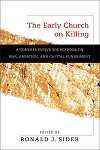
In this volume, noted theologian Ron Sider lets the testimony of the early church speak. It offers a thorough, comprehensive treatment on topics of perennial concern—war, abortion, and capital punishment—providing English translations for all extant data directly relevant to the treatment of these issues by the early church until Constantine. Primarily, it draws data from early church writings, but other evidence, such as archaeological finds and Roman writings, is included. The book contains brief introductions to every Christian writer cited and explanatory notes on many specific texts. The Early Church on Killing will be a helpful text in courses on ethics, theology, and church history.
In this very important work, Ron Sider returns to his roots as a church historian to offer an exceedingly careful, measured study of the literary evidence left by the early church on the morality of killing. This volume is entirely free of propaganda or polemics, following the evidence where it leads. This deceptively brief, highly disciplined study should prove to be authoritative in this field.
—David P. Gushee, distinguished university professor of Christian ethics, Center for Theology and Public Life, Mercer University
In a most helpful way and with an evident knowledge of the primary sources, Ronald Sider presents in translation a comprehensive sourcebook of early Christian statements on the issues of abortion, capital punishment, and military service. . . . Sider confronts the reader with the relevant texts themselves and so allows us to make our own independent judgment on the important question of the early church’s position on these difficult and yet highly relevant themes. This book will be an asset in the libraries of pastors and laypeople alike and a welcome text in college and seminary classrooms.
—William C. Weinrich, professor of historical theology, Concordia Theological Seminary
The question of ‘killing’ has been a contested and debated issue from the earliest years of the church’s history. May Christians serve in the military? Is abortion ever justifiable? What of the question of capital punishment? Ron Sider has produced an invaluable handbook of primary source material from an ancient Christian perspective that can serve the entire church well as we continue to face these thorny and often heartrending questions in a modern context.
—Christopher A. Hall, chancellor, Eastern University
In a time when violent death is all too common and wars of choice are undertaken all too readily, it is bracing to be reminded by this cloud of witnesses from the early church of the value that early Christians placed on human life and the severe judgments they issued on those who took it without cause.
—Harold W. Attridge, Sterling Professor of Divinity, Yale Divinity School
Ronald J. Sider is a distinguished professor of theology, holistic ministry, and public policy at Palmer Theological Seminary. He is the author of many books, including the bestselling Rich Christians in an Age of Hunger and The Scandal of the Evangelical Conscience.
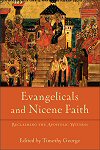
The Nicene Creed is the most universally accepted statement of Christian faith by Protestant, Catholic, and Orthodox believers alike. In this volume, top scholars examine the Nicene Creed’s connection with the evangelical tradition, presenting evangelicalism as a renewal movement within the one holy catholic and apostolic church. Particular focus is given to the Creed’s practical outworking in the life of the church—its theology, spirituality, worship, and mission. Topics include pastoral work, biblical exegesis, the emerging phenomena, and Christian orthodoxy’s revival in the Global South. The book will be useful for students of theology, church history, and spirituality. It will also appeal to pastors, church leaders, scholars, and all who wish to present the traditional Christian faith to twenty-first-century people.
Contributors:
- Thomas C. Oden
- Mark S. Gignilliat
- Frank Thielman
- Gerald Bray
- Carl L. Beckwith
- Steven R. Harmon
- Carl E. Braaten
- J. Matthew Pinson
- Curtis W. Freeman
- Elizabeth Newman
- David P. Nelson
- Kathleen B. Nielson
- John Rucyahana
- Mark DeVine
- Ralph C. Wood
This should have wide appeal and could be a huge blessing if it were studied and discussed. Fastidious patristics will love it—it is about orthodoxy and the apostolic faith, and those who wish that evangelicals were more deeply rooted will find this useful, and liberal Protestants who are in need of perhaps insight from both will, also, find this really helpful. There is a bit of an emphasis, too, on just how the Creed’s truths can be lived out—even in worship and mission and pastoral work. . . . This work brings a large amount of insight about historic faith of the fourth century to the twenty-first century.
—Byron Borger, associate staff member, Coalition for Christian Outreach
Timothy George is the dean and professor of divinity, history, and doctrine at Beeson Divinity School, Samford University. He is the author or editor of numerous books, including Theology of the Reformers, God the Holy Trinity, and Evangelical Future. He serves as executive editor for Christianity Today and is on the editorial advisory board of Books & Culture.
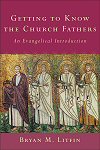
Many evangelical Christians know very little about the early church fathers. Others have heard just enough to be suspicious of them and their treatment of Scripture. Still others are becoming interested in this neglected but significant community of believers.
In Getting to Know the Church Fathers, patristics scholar Bryan Litfin introduces readers to 10 ancient Christians and dispels the misconceptions that have tainted many evangelicals’ view of them.
Litfin’s personal and accessible approach to the church fathers—including Augustine, Ignatius, Origen, Perpetua, and Tertullian—reveals the riches of the Christian tradition and how much Christians today have been shaped by them in the ways we worship, pray, study Scripture, and live as a community.
Each chapter tells the story of one figure’s life and work, and concludes with probing questions for discussion or reflection, guides to further reading, and a fresh, vivid translation from the church father’s original writings. The book is ideal for students, professors, church groups, and others seeking to learn more about historic, orthodox Christianity.
A lively and engaging introduction to the church’s earliest and most venerable teachers for evangelical readers. Shattering the stereotypes of the church fathers, Litfin shows that they were animated by the Holy Scriptures and love for Christ. Getting to Know the Church Fathers challenges evangelicals to claim the great tradition of Christian thought as their own and invites them to embrace it as their story and their heritage, not solely that of Catholics and the Orthodox.
—Robert Louis Wilken, emeritus professor, University of Virginia
A new generation of evangelicals is discovering the riches of the wider Christian tradition, including the wisdom of the early church fathers. Bryan Litfin’s patristics primer is a perfect guide for those who are on this journey, and for others who would like to take the first steps. Well researched and well written, this is a gem of a book!
—Timothy George, professor of divinity, history, and doctrine, Beeson Divinity School
Bryan Litfin has written a lively, extremely accessible introduction to the church fathers that students unfamiliar with the patristic world will find very helpful. Litfin is particularly gifted at helping evangelicals understand why the church fathers should be embraced as worthy members of the church’s family.
—Chris Hall, chancellor, Eastern University
Litfin represents a new generation of evangelicals who have been trained in patristics and can make the ancient writers accessible to contemporary readers without sacrificing solid scholarship. This book, as the title suggests, offers a creative way to explain select works of the church fathers for Protestants whose religious traditions have long forgotten them.
—D.H. Williams, professor of religion in Patristics and historical theology, Baylor University
Evangelicals’ longstanding neglect of the writings of the early church has impoverished both their lives and their theology. Bryan Litfin is a wise and welcoming guide to a firsthand, attentive knowledge of these forebears who enrich and guide our worship, service, and understanding. His thorough knowledge of these ancient Christian writings and the contemporary scholarship on them provides a winsome, accessible introduction and a sound foundation for further study.
—Stephen R. Spencer, Blanchard Professor of Theology Wheaton College
Bryan M. Litfin is a professor of theology at Moody Bible Institute.
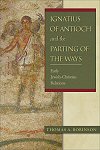
How did the early Christian movement, which began among Jewish people and in close association with the Jewish temple and synagogues of the first century, develop into a predominantly Gentile movement by the end of the first century? Was this “parting of the ways” spurred by internal tensions within the Christian church, socio-political factors in the Roman city of Antioch, or growing hostility from the larger Jewish community? In Ignatius of Antioch and the Parting of the Ways, Thomas A. Robinson addresses this intriguing historical question by taking a careful look at the writings of one of the few Christian writers who wrote about this parting firsthand—Ignatius, the Bishop of Antioch, who was martyred in the early years of the second century. Through a careful examination of the historical and sociological setting of first-century Antioch, Robinson sifts the testimony of this church father on issues such as the nature of Christian conversion at Antioch, the sources of Jewish-Christian tensions in that city and in the broader Roman world, and the development of the terms “Christian” and “Christianity.” Assessing a number of current theories about the nature of the Jewish-Christian parting, Robinson stresses the importance of hearing the voice of Ignatius himself on these questions. This is an excellent resource for anyone interested in the early days of Christianity and in Jewish-Christian relations.
A vigorous, impressively researched, and incisive study of Ignatius, firmly rooting him in historical context. Robinson challenges effectively some fashionable ideas about Ignatius and early Christianity, e.g., multiple ‘Christianities’ and ‘Judaisms,’ and the supposedly late differentiation of Christianity from its Jewish matrix. This is an important work whose arguments must be reckoned with hereafter.
—Larry Hurtado, professor, New Testament language, literature, and theology, New College, University of Edinburgh
Thomas Robinson succeeds in introducing readers to the multiple issues involved in interpreting Ignatius’ comments about Judaism with an accessible style alongside evident mastery of a wide range of recent discussion. Its detailed analysis of the social and historical setting of Jews and Christians in Antioch is a model of what is needed in exploring particular situations and writings, and will ensure that the book becomes a standard contribution to the ‘the Parting of the Ways debate’ as well as to the study of Ignatius himself.
—Judith Lieu, Lady Margaret’s Professor of Divinity, Faculty of Divinity, University of Cambridge
Robinson provides excellent engagement with and documentation of the varied discussions. In all of this, he proves a careful scholar, respectful of ancient sources (thought not naively so), and a challenger of current scholarship especially when modern sensibilities drive contemporary academics to restructure the past to make it more palatable. . . . Ignatius of Antioch and the Parting of the Ways is a wonderful volume, useful to scholars in New Testament, early Christian, and Jewish-Christian studies. The book provides a wealth of critical information and carefully reasoned arguments from a seasoned scholar, unafraid to challenge consensuses, yet careful and nuanced in his judgments.
—Journal of the Evangelical Theological Society
This tightly argued book contends that the letters of Ignatius provide clear evidence that Judaism and Christianity were distinct religious phenomena and knew themselves as different by the early years of the second century. . . . This is an important book. Robinson’s arguments lay bare significant weaknesses in the dominant hypotheses about the development of the church in the late first and early second centuries. . . . Thus, he provides a needed corrective for scholars of Ignatius and more broadly for those who offer reconstructions of the developing church and who discuss the early relationship between Judaism and Christianity.
—Biblical Theology Bulletin
Thomas A. Robinson is professor of religious studies at the University of Lethbridge in Alberta, Canada. He specializes in the relationship between Christianity and Judaism and the development of Christianity’s distinctive identity in the Roman Empire. His books include Early Christian Reader, World Religions, and Mastering New Testament Greek.
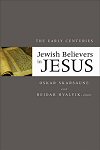
Jewish Believers in Jesus: The Early Centuries examines the formative first five centuries of Christian history as experienced by individuals who were ethnically Jewish but who professed faith in Jesus Christ as the Messiah. Offering the work of an impressive international team of scholars, this unique study examines the first five centuries of texts thought to have been authored or edited by Jewish Christians, including the Old Testament Pseudepigrapha, the New Testament Apocrypha, and some patristic works. Also considered are statements within patristic literature about Jewish believers and uses of oral traditions from Jewish Christians. Furthermore, the evidence in Jewish, mainly rabbinic, literature is examined, and room is made for a judicious sifting of the archaeological evidence. The final two chapters are devoted to an enlightening synthesis of the material with subsequent conclusions regarding Jewish believers in antiquity.
Contributors:
- Philip S. Alexander
- Richard Bauckham
- James Carleton Paget
- Anders Ekenberg
- Torleif Elgvin
- Craig A. Evans
- Donald A. Hagner
- Gunnar af Hallstrom
- Sten Hidal
- Peter Hirschberg
- Wolfram Kinzig
- Lawrence Lahey
- Graham Stanton
- James F. Strange
This is a first-rate contribution by top scholars to our understanding of Jews who believed in Jesus during the first few centuries of Christianity. Not only does the volume address in depth the many complexities of the historical, social, literary, and religious aspects of Jewish believers in Jesus, it also admirably engages the very construction of scholarship on the topic. This is a comprehensive work of meticulous and careful scholarship that should be the standard reference on the subject for years to come.
—Jeffrey S. Siker, professor and chair, Department of Theological Studies, Loyola Marymount University
Uniquely, Jewish Believers in Jesus attempts to distinguish early Christians not by ideology but by ethnicity, examining Jews in the first five centuries who continued to practice their tradition but acknowledged Jesus as the Messiah. . . . Well organized, with excerpts and references in the original languages, the text is thoroughly documented with a comprehensive bibliography of over 100 pages, and indexes of ancient sources, modern authors, and subjects. The extensive research makes this book an excellent resource for any discussion of Jewish believers in Jesus in the early centuries. . . . Recommended.
—Choice
[T]he abundance of source material will be of great use to anyone wishing to investigate these topics or periods. The material provided will lead to further study of ‘Jewish believers’ or may help one to find another designation for this group of Jewish disciples of Jesus.
—Review of Biblical Literature
This is probably the most comprehensive treatment of the subject matter in decades and is likely to remain unsurpassed for some time to come.
—Journal for the Study of the New Testament Booklist
Jewish Believers in Jesus presents an abundance of information that will no doubt be welcomed by ancient church historians and scholars of Judaism alike. The findings of the contributors of this anthology demand that a new paradigm be found to replace F. C. Baur’s thesis concerning the history of Jewish and Pauline Christianity in the first century. The articles are clearly written, conventional in outline, and would make excellent reading for college students.
—Bulletin for Biblical Research
Reidar Hvalvik is a professor of New Testament studies at MF Norwegian School of Theology in Oslo, Norway. His publications include The Struggle for Scripture and Covenant: The Epistle of Barnabas and Jewish-Christian Competition in the Second Century, an introduction to the theology of Acts, and an introduction to the New Testament (both in Norwegian).
Oskar Skarsaune is a professor of church history at MF Norwegian School of Theology in Oslo, Norway. His many publications include The Proof from Prophecy: A Study in Justin Martyr’s Proof-text Tradition, Incarnation—Myth or Fact?, and In the Shadow of the Temple.
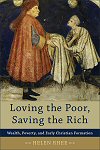
Loving the Poor, Saving the Rich: Wealth, Poverty, and Early Christian Formation
- Author: Helen Rhee
- Publisher: Baker Academic
- Publication Date: 2012
- Pages: 304
The issue of wealth and poverty and its relationship to Christian faith is as ancient as the New Testament and reaches even further back to the Hebrew Scriptures. From the beginnings of the Christian movement, the issue of how to deal with riches and care for the poor formed an important aspect of Christian discipleship.
This careful study analyzes the significance of wealth and poverty in constructing Christian identity in the complex socioeconomic situation and cultural milieu of the early Roman Empire. Helen Rhee shows how early Christians adopted, appropriated, and transformed the Jewish and Greco-Roman moral teachings and practices of giving and patronage. She examines how early Christians developed their distinctive theology and social understanding of wealth and the wealthy on one hand and of poverty and the poor on the other, demonstrating that this understanding impacted early Christian identity formation. She also explores the vital role wealth and poverty played in the construction of eschatology, soteriology, and ecclesiology in the social and cultural context of the time. In addition, the book draws out relevant implications of early Christian thought and practice for the contemporary church. Professors and students in courses on Christian origins, early Christianity, church history, and Christian ethics will value this work.
In contrast to our modern world’s way of talking about issues of wealth and poverty, Rhee takes us back to a time when confronting wealth and addressing the concerns of poverty were identity-forming experiences for the Christian church. . . . Rhee’s conclusions yield some valuable reminders that the world of early Christianity invites the world of modern Christianity to live more simply. I think Rhee will be happy if even this is as far as most readers go after reading her delightful and informative book.
—Brian Matz, assistant professor of the history of Christianity, Carroll College
Helen Rhee’s Loving the Poor, Saving the Rich provides an excellent and deeply informed study of early Christian views of wealth and poverty. Rhee’s analysis is especially sensitive to the social contexts of nascent Christian economic discourse. She presents a compelling and highly engaging analysis of the role that theologies and practices of wealth and poverty played in shaping the emergence of a distinctively Christian identity in the pre-Constantinian period. This book is essential reading for anyone interested in early and contemporary Christian understandings and practices of wealth and poverty. I commend it highly to scholars and students alike, and I will enthusiastically use it in my own research and teaching.
—David J. Downs, associate professor of New Testament studies, Fuller Theological Seminary
The past 10 years have witnessed a flurry of studies on wealth, poverty, and Christianity that have tended to focus on the New Testament and post-Constantinian periods. In Loving the Poor, Saving the Rich, Rhee produces what we have all been waiting for: a sensitive study that documents not just the ‘what’ but the ‘why’ of the important trajectory of a small and tentative Jesus movement within Greco-Roman society to an imperially endorsed and fiscally powerful church. From its beautifully articulated historical context to its final chapter that speaks to the contemporary Christian, this work sweeps beyond a mere historical study into the realms of inspiration. It is a sheer pleasure to read.
—Wendy Mayer, honorary fellow, Centre for Early Christian Studies, Australian Catholic University
Helen Rhee’s new book is the first in 30 years to provide an in-depth focus on responsible Christian giving in second- and third-century Greco-Roman church communities—and what that means for today. Historically sensitive and accurate, Loving the Poor, Saving the Rich is a welcome pastoral call to affirm the physicality of redemption and the grace of doing good.
—Susan R. Holman, member of the board, Pappas Patristic Institute of Holy Cross Greek Orthodox School of Theology
Helen Rhee is an associate professor of church history at Westmont College in Santa Barbara, California, and served as a pastor for a number of years. She specializes in early Christian history, especially second- and third- century Christian literature, and is the author of Early Christian Literature: Christ and Culture in the Second and Third Centuries.
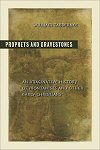
Before the great councils of Christendom and before there were centers of ecclesiastical authority that spoke on behalf of the widely scattered churches found throughout the Roman Empire, how was one to determine what teachings were true and which prophets and prophetesses were authentic?
Montanism is named for its first proponent, a certain Montanus from Phrygia in Asia Minor in what is today Turkey who began his “spirit-filled movement” within the area sometime around 165 CE. He was shortly joined by two women, Priscilla and Maximilla. All proclaimed that they were filled with the Holy Spirit and prophesied about the return of Jesus Christ as immanent and that the New Jerusalem would be established in the city of Pepouza in Phrygia.
With his profound knowledge of the group known at that time as “The New Prophecy” William Tabbernee dramatically tells the story of the followers of Montanus, Maximilla, and Priscilla, as well as of those other Christians, some well known such as Tertullian, most not, who followed their teachings for centuries thereafter. Replete with vivid descriptions, photographs of, and drawings illustrating the places and events surrounding these men and women, and with maps to orient the reader in the geography of its origins, this book provides an articulate, erudite, and thoroughly fascinating tour-de-force of what has been labeled a Christian heresy almost from its inception.
William Tabbernee is no stranger to Montanism. . . . Indeed, his previous monographs . . . put him at the forefront of Montanist scholarship. With this present volume he brings his sense of geography and location to bear on the historical and epigraphic evidence, but in a way that is unlike anything he or other scholars have written before. . . . Tabbernee provides a narrative account of the historical, literary, and epigraphic evidence or fleshes out existing narratives by incorporating topographical elements (along with photographs) from his own archaeological insights. What is imaginative about the book is the way he humanizes his account, suggesting the emotions of the characters and filling in the backgrounds of some of the narratives in Eusebius and others. . . . Each vignette in this volume is short and delightfully readable. . . . At the end of each brief narrative the list of sources and the notes provide the historical grounding to assure the reader that this is not a work of fiction or even fictionalized history. Tabbernee has taken a stand on a number of debated issues. . . . Careful attention will need to be paid to the notes by those unfamiliar with particular episodes to reveal that there is a considerable amount of scholarly debate about these issues. . . . Given that Montanism suffered the same fate as other defeated groups in that their version of events was mostly wiped from history, Tabbernee provides a sympathetic reading, helping the reader not only to grasp but also to feel the passion and the position of both Montanists and their opponents alike.
—Catholic Historical Review
[It] provides a detailed, chronologically arranged overview of all the important historical information on the history of Montanism. . . . The book may be written in the style of a novel, but this should not obscure the fact that Tabbernee uses all the relevant texts, which are duly registered in the notes, and woven into his account. Further, the notes refer to modern research contributions, including the latest scholarly literature, on aspects of Montanism and the early Church. . . . The narrative part is prefaced by a list of the archaeological maps and drawings or photographs of the archaeological evidence. Readers will also be grateful to Tabbernee for the chronological table . . . which sets out in parallel the dates of the emperors’ reigns and the persons and events discussed in the text. At relevant points helpful maps, six in all, provide both overviews and detail on the geography of Montanism. . . . [A] very readable history of Montanism. Whereas the specialized literature, which is often unreadable, does not necessarily guarantee a better scholarly insight into the subject, the present work offers an original alternative: it is based on the sources and supplies all the necessary facts and references to modern research.
—Theologische Literaturzeitung
William Tabbernee is the former president and Stephen J. England Distinguished Professor of the History of Christianity at Phillips Theological Seminary in Tulsa, Oklahoma. A world-renowned specialist on Montanism, he led an international team of archaeologists and historians that discovered the long-lost site of Pepouza, Montanism’s most holy city. He is the author of Montanist Inscriptions: Epigraphic Sources Illustrating the History of Montanism, Fake Prophecy and Polluted Sacraments: Ecclesiastical and Imperial Reactions to Montanism, and (with Peter Lampe) Pepouza and Tymion: The Discovery and Archaeological Exploration of a Lost Ancient City and an Imperial Estate.
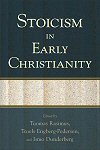
How usefully do distinctly Stoic ideas illuminate the meaning of first- and second-century Christian texts? This book suggests that early Christians—the authors of New Testament and noncanonical writings, including some early apologies—were often more influenced by Stoicism than by Middle Platonism. This insight sheds an entirely new light on the relationship between philosophy and religion at the birth of Christianity. The book will appeal to scholars, graduate students, and libraries interested in New Testament studies and the early church.
This important collection of essays will be of interest to all those concerned with seeing the early Christian movement within the broader context of the Greco-Roman world. The focus on Stoicism here opens valuable new insights into aspects of early Christianity and will be a major stimulus for future research.
—Christopher Tuckett, professor of New Testament studies, Pembroke College, University of Oxford
This volume, a virtual compendium of important Stoic teaching, clearly illumines—through close and careful textual study—the original significance of many passages in early Christian texts that deal with personal and communal conduct, the nature of Christian freedom, mastery of the emotions, the importance of embodied life and moral progress, the relation between human freedom and divine providence, and the tension between the divine immanence and transcendence of the created order. Individually and collectively, this set of essays brings to our awareness the distinctive contribution to Christian thought of an often overlooked school of ancient thought.
—John D. Turner, professor of religious studies, University of Nebraska
This is a book for which we have been longing for many decades! The relationship between Platonism and Christianity has dominated academic debates while the influence of Stoicism has been largely neglected. This volume deftly treats all relevant areas in which Stoic influences may shape early Christian theology and in so doing transcends the Judaism/Hellenism divide.
—Samuel Vollenwieder, chair of New Testament studies, Universität Zürich
Tuomas Rasimus is a research fellow in the department of biblical studies at the University of Helsinki and at the Institut d’études anciennes, Université Laval. He is the author of Paradise Reconsidered in Gnostic Mythmaking: Rethinking Sethianism in Light of the Ophite Evidence.
Troels Engberg-Pedersen is professor of New Testament in the Faculty of Theology at the University of Copenhagen. He is the author or editor of 11 books and more than one hundred articles.
Ismo Dunderberg is a professor of New Testament studies at the University of Helsinki. He is the author or editor of four books and numerous articles in the field of early Christian literature.
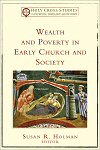
Wealth and poverty are issues of perennial importance in the life and thought of the church. This volume brings patristic thought to bear on these vital issues. The contributors offer explanations of poverty in the New Testament period, explore developments among Christians in Egypt and Asia Minor and in early Byzantium, and connect patristic theology with contemporary public policy and religious dialogue.
Contributors:
- David Brakke
- Rudolf Brandle
- Denise Kimber Buell
- Daniel Caner
- Francine Cardman
- Demetrios J. Constantelos
- Steven J. Friesen
- Gorge Hasselhoff
- Angeliki E. Laiou
- Brian Matz
- Wendy Mayer
- Edward Moore
- Timothy Patitsas
- Adam Serfass
- A. Edward Siecienski
- Annewies van den Hoek
- Efthalia Makris Walsh
This is a splendid book, a substantial contribution on a topic of perennial import for scholars of religion and theology. The essays collected here offer important reassessments of scholarship to date. They present fresh, vivid material and provide revised models through which to study, reflect upon, and respond to deprivation and surplus as realities in antiquity and in our own time. Practical, pragmatic considerations are interwoven with cultural, historical, and theological analyses. Excellent work throughout!
—Susan Ashbrook Harvey, Willard Prescott and Annie McClelland Smith Professor of Religious Studies, Brown University
In this collection of essays, the reader will find insightful questions raised and conclusions made concerning the early Christian perspectives of need and surplus. It is refreshing to find careful attention paid to the kind of complexities that existed in the minds of those who wrote, directly or (mostly) indirectly, on these matters.
—D.H. Williams, professor of religion in patristics and historical theology, Baylor University
The social obligations of the wealthy and the needs of the poor in the teachings and practices of early Christians are examined in these essays with rich insight, having much contemporary value. The authors remind us that for the patristic mind, virtue cannot be separated from piety and learning. To praise the living God as philanthropos and to recall his saving actions also require a genuine love for human persons, especially the poor.
—Thomas FitzGerald, dean and professor of church history and historical theology, Holy Cross Greek Orthodox School of Theology
This collection of essays has a number of strengths. Clearly, the study is driven by a serious interaction with key patristic texts addressing wealth and poverty. . . . A second area of notable strength in Wealth and Poverty is that a concerted effort was made to define poverty in the patristic period. . . . Susan Holman has done a noteworthy job of editing a volume of diverse essays that address an important question in patristic studies. As an academic resource, this text might be used in a graduate-level patristics seminar. In the very least, it should be listed as a useful secondary source for early Christian research projects.
—Journal of Early Christian Studies
This volume should contribute to studies in poverty and patristics as a reference work. . . . In a seminary level study of poverty several of the essays would be quite helpful.
—Trinity Journal
Susan R. Holman is the author of The Hungry Are Dying: Beggars and Bishops in Roman Cappadocia, a member of the board of the Pappas Patristic Institute of Holy Cross Greek Orthodox School of Theology, and the creator of PovertyStudies.org.
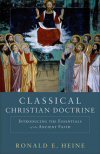
This clear and concise text helps readers grasp the basic doctrines of the Christian faith from the earliest days of Christianity. Ronald Heine, an internationally known expert on early Christian theology, developed this book after many years of teaching Christian doctrine. Heine primarily uses the classical Christian doctrines of the Nicene Creed to guide students into the essentials of the faith. Sidebars identify major personalities and concepts, and each chapter concludes with discussion questions and suggestions for further reading.
If you are searching for a solid and solidifying introduction to the doctrines of early Christianity, this is it. Ronald Heine helps those of us who feel unsettled within our transitory age to find some steadiness of faith within the classical and foundational. This is a book for those who think beginnings might be important to beliefs, who think antiquity might enrich the contemporary, and who, because they don’t like to free-fall, appreciate the groundwork.
—D. Jeffrey Bingham, associate dean of biblical and theological studies, Wheaton College
One couldn’t ask for a clearer or more succinct account of the process whereby classical Christian doctrines were articulated. Shaped by the clauses of the Nicene Creed, it brilliantly sketches out how the early church fathers debated and appropriated scriptural themes. This sharp focus and the judicious selection of key elements in what can seem a dauntingly complex story make this an excellent initial text. Also of value are telling quotations from original sources in clear English translation and good questions to make beginning students think hard about doctrinal questions.
—Frances Young, emeritus professor of theology, University of Birmingham
Ronald E. Heine is professor of Bible and Christian ministry at Northwest Christian University in Eugene, Oregon. He is the author of Reading the Old Testament with the Ancient Church and several books on Origen.
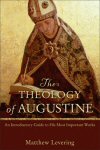
Most theology students realize that Augustine is tremendously influential in the Christian tradition as a whole, but they generally lack real knowledge of his writings. This volume introduces Augustine’s theology through seven of his most important works. Matthew Levering begins with a discussion of Augustine’s life and times and then provides a full survey of the argument of each work with bibliographical references for those who wish to research further. Written in clear, accessible language, this book offers an essential introduction to the major works of Augustine, from which anyone interested in church history will benefit.
Matthew Levering introduces Augustine through seven of his most important texts—a wonderful idea. Augustine shines out as one whose theology focuses on the central mystery of the Christian faith, God’s gracious drawing of humanity into the divine life through the work of the incarnate Word and the life-giving Spirit. Levering’s treatment beautifully complements existing introductions, providing a guide that should aid generations of students and inspire the interested lay reader.
—Lewis Ayres, Bede Chair in Catholic Theology, Durham University
The current reawakening of interest in Augustine’s theology has created a great need for an introduction that is elevated enough to be of interest to specialists and yet accessible enough to be read by students and readers from other disciplines. Levering’s study meets exactly that need. It points the way for those who are interested in how Augustine is relevant to our own theological quandaries, and it guides those who are just beginning to find their way in things Augustinian by helping them see theological themes as they are embodied in whole texts. An excellent contribution!
—John Cavadini, professor of theology, University of Notre Dame
Matthew Levering earned a PhD from Boston College and is currently professor of religious studies at the University of Dayton. He is the author of Ezra & Nehemiah in the Brazos Theological Commentary on the Bible series, and coauthor of Holy People, Holy Land and Knowing the Love of Christ.
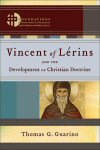
The theology of Vincent of Lérins is often reduced to a memorable slogan: “We hold that faith which has been believed everywhere, always, and by everyone.” Thomas Guarino argues that this Vincentian Canon has frequently been taken out of context. This book introduces Vincent’s thought and its reception in Christian history, exploring Vincent’s creative and innovative understanding of the development of doctrine and showing how it informed the thought of John Henry Newman. Guarino contends that Vincent’s theology contributes significantly to twenty-first-century theology and ecumenism.
Any student of theology interested in the problem of the development of doctrine must take seriously the full measure of Guarino’s carefully researched book. He not only provides us with brilliant historical scholarship but also demonstrates the enduring pertinence of the Vincentian Canon, which is too often reduced to a catchphrase. This volume is a splendid example of authentic ressourcement.
—Lawrence S. Cunningham, John A. O’Brien Professor of Theology, University of Notre Dame
Of the splendid Commonitorium of Vincent of Lérins, many Christians know only one sentence—if that. Thomas Guarino remedies the situation superbly. He offers a full reading of the Commonitorium and of Vincent’s complex thought on the development of doctrine. He then moves on to John Henry Newman’s cautious interpretation of Vincent and ends with a reflection on Vincent in contemporary theology and ecumenism. From the Council of Nicaea to Vincent to Newman to Vatican II and beyond, this is a challenging journey, beautifully presented.
—Joseph T. Lienhard, professor, Fordham University
Thomas G. Guarino is professor of systematic theology at Seton Hall University in South Orange, New Jersey. He is the author of Vattimo and Theology, Foundations of Systematic Theology, and more.
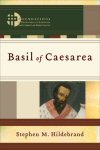
Basil of Caesarea
- Author: Stephen M. Hildebrand
- Series: Foundations of Theological Exegesis and Christian Spirituality
- Publisher: Baker Academic
- Publication Date: 2014
- Pages: 224
This introduction to the thought of Basil of Caesarea surveys his theological, spiritual, and monastic writings, showing the importance of his work for contemporary theology and spirituality. It brings together various aspects of Basil's thought into a single whole and explores his uniqueness and creativity as a theologian. The volume engages specialized scholarship on Basil but makes his thought accessible to a wider audience. It is the third volume in the Foundations of Theological Exegesis and Christian Spirituality series, which critically recovers patristic exegesis and interpretation for contemporary theology and spirituality.
Basil's reputation as a theologian has grown remarkably--and deservedly--in the past few years. New scholarship and new translation has reminded us that Basil is one of the great theologians and Christian teachers of the fourth century. Stephen Hildebrand's book is a very welcome introduction to the 'new Basil.' Hildebrand now takes his place alongside such significant Basilian scholars as Andrew Radde-Gallwitz and Mark DelCogliano.
—Lewis Ayres, Professor of Catholic and Historical Theology, Durham University
Basil of Caesarea is the giant of the fourth-century theologians, and he intimidates many who approach his works today. Here lies the value of Stephen Hildebrand's book: he introduces us not to a part of Basil's thought but to his theology as a whole. Moreover, he introduces not merely a corpus of ancient texts but also their author. This is a valuable book not only for historians of theology but for anyone who wants to understand the role of theology in late antiquity.
—Thomas O'Loughlin, professor of historical theology, University of Nottingham
Basil is a pivotal figure in the history of the church, and his biblical interpretation is no small part of this achievement. We cannot begin to understand his prodigies of charitable activity or ecclesiastical administration until we understand his ascesis and his contemplative approach to Scripture. This book is more than a look back. At a time when the world is regaining an appreciation of social doctrine, spiritual discipline, and patristic exegesis, it is a way forward
—Scott Hahn, Pope Benedict XVI Chair of Biblical Theology and Liturgical Proclamation, St. Vincent Seminary; professor of scripture and theology, Franciscan University of Steubenville
Stephen M. Hildebrand is professor of theology and director of the theology graduate program at Franciscan University of Steubenville in Steubenville, Ohio. He is the author of The Trinitarian Theology of Basil of Caesarea and has published a translation of On the Holy Spirit.
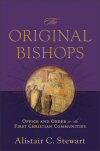
The Original Bishops: Office and Order in the First Christian Communities
- Author: Alistair C. Steward
- Publisher: Baker Academic
- Publication Date: 2014
- Pages: 416
This work provides a new starting point for studying the origins of church offices. Alistair Stewart, a leading authority on early Christianity and a meticulous scholar, provides essential groundwork for historical and theological discussions. Stewart refutes a long-held consensus that church offices emerged from collective leadership at the end of the first century. He argues that governance by elders was unknown in the early centuries and that bishops emerged at the beginning of the church; however, they were nothing like bishops of a later period. The church offices as presently known emerged in the late second century. Stewart debunks widespread assumptions and misunderstandings, offers carefully nuanced readings of the ancient evidence, and fully interacts with pertinent secondary scholarship.
Building on a number of new trends in scholarship and grounded in impressive mastery of the sources, this study drives a coach and horses through the long-standing consensus that presbyters and bishops were once the same and early church governance was collegial. Its challenge to anachronistic reading of the sources should finally undermine contemporary claims to historical precedent in debates about ministry, whether those claims be denominational, ecumenical, or feminist, highlighting as it does the 'otherness' of the socio-cultural order within which the emerging church developed an organization suited to its own needs yet indebted in terminology and practice to its historical context. The Original Bishops is a tour de force, creating a coherent yet complex narrative that, despite its frequent acknowledgment of ignorance given the scrappy nature of the evidence, is sure to be contested. Future discussion of the issues, however, will be unable to ignore this book.
—Frances Young, emeritus professor, University of Birmingham
Stewart shines fresh light on a pivotal theme in late Christian antiquity—the emergence of ecclesiastical offices under the rubrics of presbyter and bishop. He explains with vigor the rise of each category within the framework of individual churches throughout the Roman Empire, from the advent of the Apostle Paul to the turn of the third century, challenging age-old views offered by Lightfoot and others of his generation. Stewart's understanding of the regional presbytery as a collective association of local bishops delivers novel insight into the divergent use of such terminology throughout apostolic and post-apostolic literature. This book is carefully written and demands vigilant reading. Its clear and resourceful analysis of the maze of data from ancient authors—ever a focus of intrigue among contemporary scholars—will engage readers at every level, from the introductory student to the polished specialist!
—Clayton N. Jefford, professor, Saint Meinrad Seminary and School of Theology
This book is a masterwork. With massive erudition, Alistair Stewart elaborates here a bracing hypothesis revising several standard views about the origin of bishops, presbyters, and deacons in the first Christian centuries. Future histories of early Christian ministry will have to take into account the impressively wide scope of Stewart's evidence as well as the arguments he builds on that evidence. The book is valuable for the vast amount of modern scholarship that it gathers on this question as well as for the fresh proposals it brings to the interpretation of numerous ancient Christian sources.
—Joseph G. Mueller, SJ, associate professor and director of graduate studies, Marquette University
Alistair C. Stewart is team vicar of Upton-cum-Chalvey, Slough, England, and visiting scholar of Sarum College in Salisbury, England. Recognized as a leading expert on early Christian liturgy and polity, he is the author or editor of a dozen books.
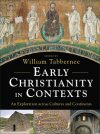
Early Christianity in Contexts: An Exploration across Cultures and Continents
- Editor: William Tabbernee
- Publisher: Baker Academic
- Publication Date: 2014
- Pages: 512
This major work draws on current archaeological and textual research to trace the spread of Christianity in the first millennium. William Tabbernee, an internationally renowned scholar of the history of Christianity, has assembled a team of expert historians to survey the diverse forms of early Christianity as it spread across centuries, cultures, and continents.
Organized according to geographical areas of late antiquity, this book examines what various regions looked like before and after the introduction of Christianity. How and when was Christianity (or a new form or expression of it) introduced into the region? How were Christian life and thought shaped by the particularities of the local setting? And how did Christianity in turn influence or reshape the local culture? The book's careful attention to local realities adds depth and concreteness to students' understanding of early Christianity, while its broad sweep introduces them to first-millennium precursors of today's variegated, globalized religion.
The global presence of Christian faith is now accepted as commonplace. This carefully researched volume demonstrates convincingly how very early that presence came to an extraordinary range of world locations. Close attention to material and cultural evidence makes this an unusually illuminating book.
—Mark A. Noll, author, Turning Points: Decisive Moments in the History of Christianity
Foregrounding the material record of Christianity in the first centuries of the Common Era, Early Christianity in Contexts magnificently captures the diversity of Christian experience within and beyond the borders of the Roman world. First-rate research infuses this welcome volume from start to finish, rewarding those who immerse themselves in its captivating treasures.
—Bruce Longenecker, professor, W.W. Melton Chair of Religion, Baylor University
This is—as always with Tabbernee's books—a carefully written, precise, and well-documented book, but also a book that is a pleasure to read. The chapters contain trustworthy overviews, including the most interesting sources and secondary literature. Those references will allow readers to seek further information. As far as I can see the newest findings and excavations are integrated into the manuscript, and the fact that 'Christianity outside the boundaries' (of the Roman Empire) is included makes the book so valuable. There is no other comparable volume where the new findings from China are integrated in the traditional picture. In short: solid information on archaeological matters is combined with state-of-the-art passages on the history of Christian theologies and denominations.
—Christoph Markschies,professor, Humboldt-Universität zu Berlin
William Tabbernee, ordained in the Christian Church (Disciples of Christ), is executive director of the Oklahoma Conference of Churches. He formerly served as president and Stephen J. England Distinguished Professor of the History of Christianity at Phillips Theological Seminary. Tabbernee led an international team of archaeologists and historians that discovered the long-lost site of Pepouza, Montanism's most holy city. He is the author of numerous books, including Prophets and Gravestones, and lives in Edmond, Oklahoma.
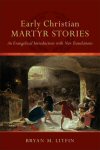
Early Christian Martyr Stories: An Evangelical Introduction with New Translations
- Author: Bryan M. Litfin
- Publisher: Baker Academic
- Publication Date: 2014
- Pages: 192
Personal narratives are powerful instruments for teaching, both for conveying information and for forming character. The martyrdom accounts preserved in the literature of early Christianity are especially intense and dramatic. However, these narratives are not readily available and are often written in intimidating prose, making them largely inaccessible for the average reader. This introductory text brings together key early Christian martyrdom stories in a single volume, offering new, easy-to-read translations and expert commentary. An introduction and explanatory notes accompany each translation. The book not only provides a vivid window into the world of early Christianity but also offers spiritual encouragement and inspiration for Christian life today.
Reflections on Christian martyrdom often either exaggerate or debunk. Bryan Litfin's book on early Christian martyrs is different. It will satisfy not only academics looking for careful documentation but also readers in general, who should appreciate it for encouraging edification as well as solid scholarship.
—Mark A. Noll, author, Turning Points: Decisive Moments in the History of Christianity
This anthology of the most reliable early Christian martyr stories ought to be required reading for all disciples of Christ. It puts today's Christian 'witnesses' in touch with our ancient spiritual role models, inspiring us to greater acts of faithfulness and courage. Litfin's historical introductions offer just what we need to understand and apply these stories in the twenty first century—when many more disciples of Christ are suffering persecution than ever before in the history of the world.
—Douglas A. Sweeney, professor, Trinity Evangelical Divinity School
Professor Litfin, author of an authoritative introduction to the theology of the early Christians, now provides us with a guide to some of their lives—and deaths. Their witness was inspired by their faith in Christ's glorious resurrection and their hope for the coming fullness of his kingdom. Do we too have this freedom, this faith, hope, and love? Inspired by this marvelous book about the friends of Jesus, let us commit ourselves anew to dying with Jesus, so as to live. Only in him will we find the unity and communion that we seek.
—Matthew Levering, Perry Family Foundation Professor of Theology, Mundelein Seminary
Bryan M. Litfin is professor of theology at Moody Bible Institute in Chicago, Illinois. He is the author of several books, including Getting to Know the Church Fathers, and numerous scholarly articles and essays.
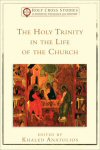
The Holy Trinity in the Life of the Church
- Editor: Khaled Anatolios
- Series: Holy Cross Studies in Patristic Theology and History
- Publisher: Baker Academic
- Publication Date: 2014
- Pages: 272
In this volume, a noted theologian brings together an ecumenical roster of leading scholars to explore Trinitarian faith as it is concretely experienced in the life of the church. Drawing upon and fostering renewed interest in Trinitarian theology, the contributors—including Brian E. Daley, John Behr, and Kathleen McVey—clarify the centrality of Trinitarian doctrine in salvation, worship, and life. This is the third volume in Holy Cross Studies in Patristic Theology and History, a partnership between Baker Academic and the Pappas Patristic Institute of Holy Cross Greek Orthodox School of Theology. The series is a deliberate outreach by the Orthodox community to Protestant and Catholic seminarians, pastors, and theologians.
This book brings together an all-star cast of theologians to explain the role of the Holy Trinity in the life of the church. It also represents the very best of Eastern Orthodox ecumenism. No one interested in the doctrine of the Trinity can afford to overlook this work.
—George Hunsinger, professor, Princeton Theological Seminary
In the last thirty years, scholars have revolutionized our understanding of how, over the course of its earliest centuries, the Christian church came to speak of God as Trinity. This wide-ranging collection of essays both catches readers up on the fruits of that research and pushes it forward. Khaled Anatolios has gathered an excellent array of scholars to explore various contours of this most profound mystery of the Christian faith. And they start where they should, with Christian liturgy, for it is out of the experience of worship—of baptism, of meditation on the Scriptures, of Eucharist—that the trinitarian faith of Christians is rooted, is experienced, is savored.
—William Harmless, SJ, Creighton University
In this rich collection of essays, a holy impatience enlists meticulous historical scholarship to articulate the trinitarian dynamics at work, whether recognized or not, in the faith lives of Christian communities. Convinced that ressourcement opens the path to a revitalized trinitarian theology, the authors trace the connections between liturgy, Scripture, theology, and spirituality in patristic literature, offering fresh readings of major figures, in the face of which conventional truisms fall away. Representing Orthodox, Roman Catholic, and Protestant traditions, they are no mere antiquarians but write with an eye to the relevance of their research for contemporary theology, ecumenism, and issues of gendered speech about God.
—William P. Loewe, professor, Catholic University of America
Khaled Anatolios is professor of historical theology in the Boston College School of Theology and Ministry in Chestnut Hill, Massachusetts. He is the author of Retrieving Nicaea: The Development and Meaning of Trinitarian Doctrine, Athanasius: The Coherence of His Thought, and the Athanasius volume in Routledge's Early Church Fathers series. Anatolios was named a Henry Luce III Fellow in Theology for 2011–2012. He is also on the steering committee of the Boston Colloquy in Historical Theology and on the board of directors of the Pappas Patristic Institute at Holy Cross Greek Orthodox School of Theology.
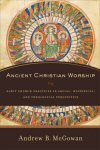
Ancient Christian Worship: Early Church Practices in Social, Historical, and Theological Perspective
- Author: Andrew B. McGowan
- Publisher: Baker Academic
- Publication Date: 2014
- Pages: 320
This introduction to the origins of Christian worship illuminates the importance of ancient Christian worship practices for contemporary Christianity. Andrew McGowan, a leading scholar of early Christian liturgy, takes a fresh approach to understanding how Christians came to worship in the distinctive forms still familiar today. Deftly and expertly processing the bewildering complexity of the ancient sources into lucid, fluent exposition, he sets aside common misperceptions to explore the roots of Christian ritual practices—including the Eucharist, baptism, communal prayer, preaching, Scripture reading, and music—in their earliest recoverable settings. Students of Christian worship and theology as well as pastors and church leaders will value this work.
This is the book that I wish I had written, but Andrew McGowan has done it so much better. Easily accessible to a nonspecialist reader, it nevertheless contains the fruit of the most up-to-date academic scholarship. Anyone wanting a reliable and comprehensive introduction to the practices of the early Christians must start here.
—Paul Bradshaw, emeritus professor of liturgy, University of Notre Dame
Ancient Christian Worship is the book that scholars, teachers, and students of early Christianity and liturgical history have long needed. Andrew McGowan provides an authoritative, accessible, and up-to-date synthesis of what we know (and do not know) about the worship lives of the ancient Christians. Anyone interested in the early church or Christian liturgy will learn from this gracefully written and clearly argued book.
—David Brakke, Joe R. Engle Chair in the History of Christianity and professor of history, Ohio State University
Andrew McGowan here provides a clear and beautifully written introduction to ancient Christian worship. While never oversimplifying the richness and complexity of his subject, McGowan has produced a study that is simultaneously comprehensive and accessible. All readers, from beginners to those more advanced, will be rewarded by both his erudition and his insight. This work justifiably will be cherished by students and teachers alike for generations to come.
—Robin Jensen, Luce Chancellor's Professor of the History of Christian Art and Worship, Vanderbilt University; author of Baptismal Imagery in Early Christianity
Andrew B. McGowan, an Anglican priest, is president and dean of the Berkeley Divinity School and the J. L. Caldwell McFaddin and Rosine B. McFaddin Professor of Anglican Studies and Pastoral Theology at Yale Divinity School. He previously served as warden of Trinity College, University of Melbourne, and is the author of Ascetic Eucharists: Food and Drink in Early Christian Ritual Meals.